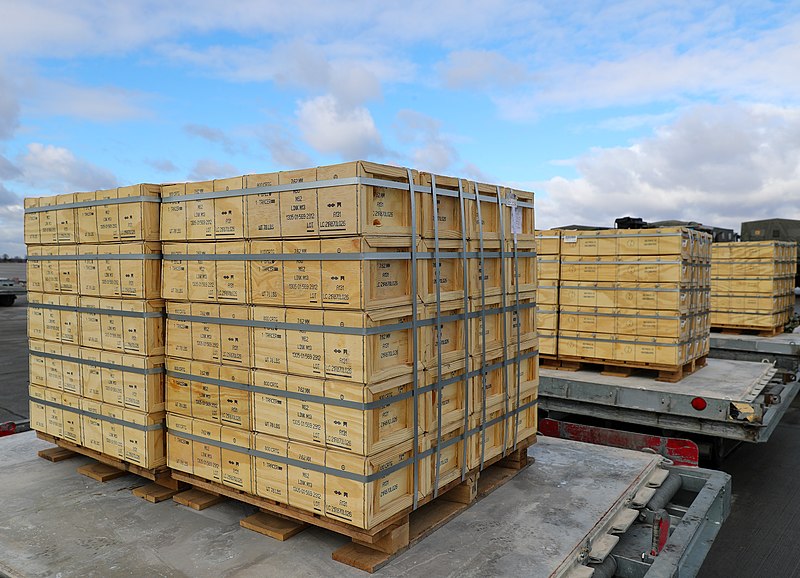 Ammunition Transferred to Ukraine as Part of U.S. Defense Assistance, January-February 2022. Photo Courtesy of the U.S. Embassy in Kyiv, Ukraine.
Ammunition Transferred to Ukraine as Part of U.S. Defense Assistance, January-February 2022. Photo Courtesy of the U.S. Embassy in Kyiv, Ukraine.
A Ukrainian Victory Relies on Accelerated Western Security Assistance
The Biden Administration’s January 24th reversal of its initial decision not to send M1 Abrams tanks to Ukraine follows a concerning trend among Western states’ security assistance to Ukraine. The pattern is consistent with nearly every request for a specific weapon system: Ukraine makes a request, the West debates it for weeks or months, then eventually approves transfers under Ukrainian pressure. The delay caused by these debates compounds on the logistical delays of transferring material—two to four months for U.S. tanks—and gives Russia time to anticipate and revise its strategy around these systems. Critically, the U.S. contingent of tanks will likely arrive after the rumored Russian spring offensive. Timely supply of security aid to Ukraine directly contributes to the achievement of Ukrainian objectives. Conversely, delays cause Ukraine to miss windows of opportunity and impedes its ability to respond effectively to Russian strategies.
The U.S. and German reluctance to export modern main battle tanks came weeks after Ukrainian President Zelensky renewed his acquisition efforts. In this hesitation, the West raised concerns of escalation and the logistics of maintaining and repairing the tanks. Four days after reports that no agreement to send tanks had been made between allies, the U.S. said it would send 31 M1 Abrams to Ukraine, and Germany announced a transfer of fourteen Leopard 2’s and permission for other states to send their Leopard tanks. The taboo is broken, but the preceding lock step dance cost the most valuable resource of the war, time.
The U.S. has lagged on several Ukrainian requests. Air defense systems like the Patriot missile system were delayed for months over concerns about their complexity. Meanwhile, Russian missiles terrorized the skies over Ukraine. Since the war began, Ukraine has requested missile systems that could hit targets well-beyond the frontline. The U.S. waited until June 2022 to provide HIMARS missile systems, which have proven highly effective. However, these systems were reportedly modified to be incompatible with the, Ukrainian requested, ATACMS missiles, which have a 200 mile range. Even if the U.S. provides these missiles, it is unknown if the modifications to the HIMARS can be reversed. ATACMS would allow Ukraine to strike Russian targets far beyond the frontline and could be critical to impeding Russia’s preparations for its spring offensive. However, the U.S. fears Russian escalation if these missiles are supplied.
Fears of escalation are the most common reasons for these delays. This is a legitimate concern for the West as a NATO-Russian war could prove catastrophic. The “slow roll” tactic may seem effective to calm Russian anxiety, but it costs Ukraine its momentum and ability to seize opportune moments of Russian weakness. As ambassador McFaul explains, Russia can really only escalate with nuclear weapons, but this tactic would result in mutual assured destruction due to a NATO response. Even a tactical nuclear weapon would only increase Western involvement and Ukrainian vigor. Additionally, the assertion that time is on the Ukrainian side is changing as casualty ratios were estimated at 1:1 in November, and Ukrainian munitions threaten to run dry without Western aid. The only accomplishment of a Western slow roll is the attrition of Ukrainian forces and giving Russia time to plan its strategy. Russia will continue to scare the West with ominous, catastrophizing statements—none of which have materialized—as long as Ukraine receives aid, but the West’s best security interests lie in accelerating assistance to Ukraine. A quicker end to the war, catalyzed by robust Western security assistance, is more attractive than Ukraine slowly bleeding out.
These debates do serve a purpose and fears of escalation are sincere. Western aid must carefully tread the line between provocation and victory. However, we also know how Russia will continue to act if it’s not defeated, and we should better enable Ukraine to determine the trajectory of this war. Because these systems require lengthy training and transfer times, having them in Ukrainian hands to use when they are needed, like the Russian spring offensive—that the M1 Abrams will likely miss—is critical. Finally, the West must weigh the risk between Russian escalation and Ukrainian attrition. Ukraine will continue to be reliant on Western economic and security aid as its infrastructure and military resources are destroyed, and slow-rolling that aid helps enable the Russian belief in victory. The timely provisioning of these tools will determine the success or failure of Ukrainian objectives. As Russia maneuvers into a war of attrition, the West must provide these tools in a timely manner to ensure a Ukrainian victory.





